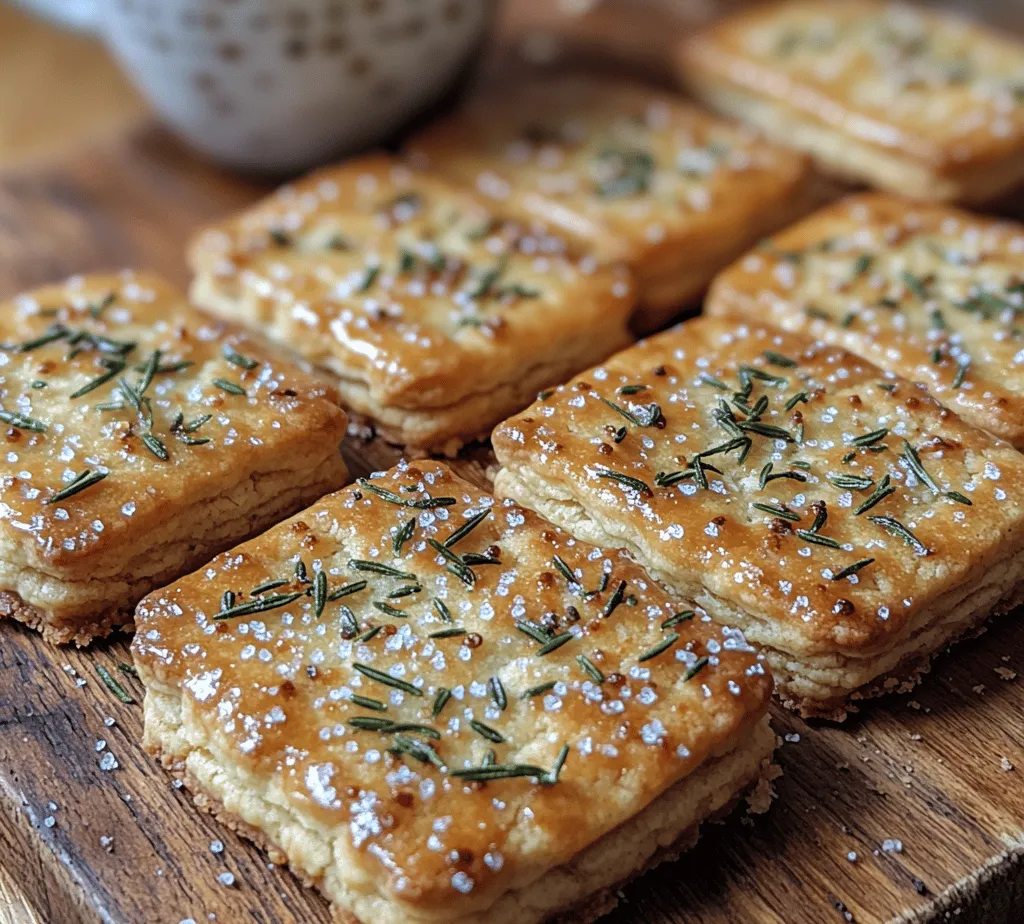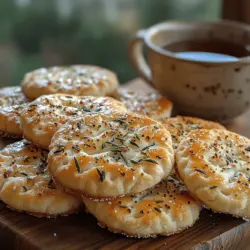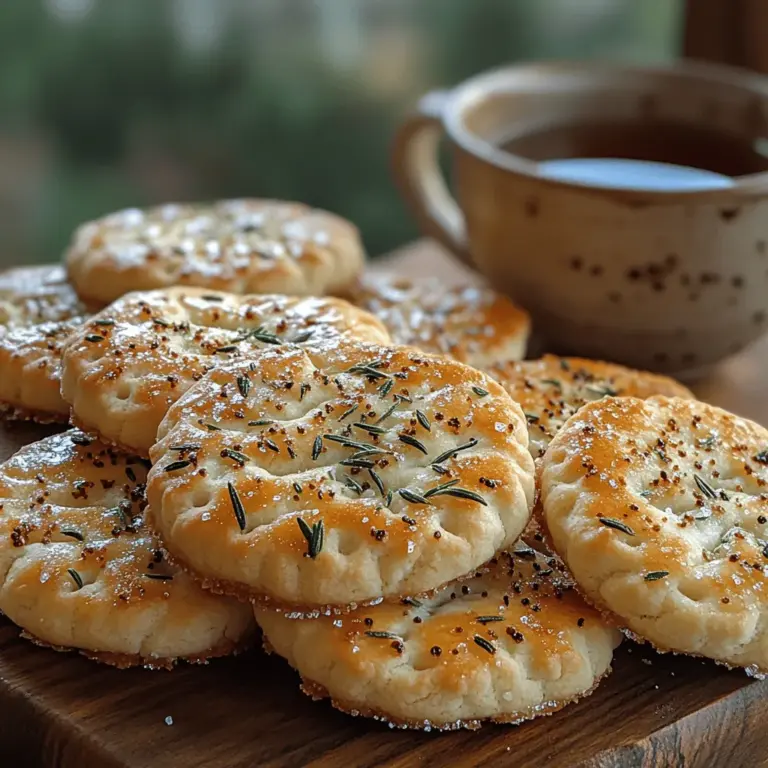Introduction
Shortbread cookies have long held a cherished place in the hearts and taste buds of dessert lovers worldwide. With their rich, buttery flavor and crumbly texture, they epitomize classic baking. Originating from Scotland, these delightful treats have evolved over centuries, yet their fundamental appeal remains unchanged. Traditionally simple, shortbread consists of just a few key ingredients, allowing the flavors to shine through beautifully.
Today, we’re taking this timeless favorite to a whole new level by infusing it with rosemary, a fragrant herb that adds a unique twist to the conventional recipe. Rosemary’s robust aroma and slightly pine-like flavor create an unexpected yet harmonious balance with the sweetness of shortbread, transforming the way we think about this beloved cookie. The use of fresh herbs in baking has gained popularity, not only for their distinctive flavors but also for their aromatic qualities that can elevate even the simplest recipes to gourmet status.
In this guide, we will explore the wonders of rosemary-infused shortbread delights, celebrating their simplicity and the delightful results they yield. Whether you’re a seasoned baker or looking to try something new, this recipe promises an easy yet rewarding experience.
The Allure of Shortbread Cookies
Shortbread has a rich history that dates back to the 12th century in Scotland. Originally made from leftover bread dough, shortbread was transformed over time into the buttery cookies we know today. The classic recipe calls for just three main ingredients: butter, sugar, and flour. This minimalistic approach makes shortbread not only simple to prepare but also allows for a wide range of variations, showcasing different flavors and textures.
Across the globe, various cultures have put their own twist on shortbread. For example, in England, you might find a crispier version known as “Petticoat Tails,” cut into wedges and often enjoyed with tea. In Australia, a similar treat is known as “ANZAC biscuits,” incorporating oats for added texture. From savory to sweet, shortbread has adapted, proving its versatility as a baking staple.
The texture of classic shortbread is one of its most appealing qualities. It should be crumbly yet melt-in-your-mouth tender. The flavor is predominantly buttery, with a subtle sweetness that beckons for a cup of tea or coffee. Shortbread cookies are frequently served at special occasions, from holiday gatherings to afternoon teas, making them a beloved treat for both casual snacking and elegant events.
Why Rosemary? The Benefits of Infusing Herbs into Baking
When it comes to baking, the addition of fresh herbs can significantly elevate a dish. Rosemary, a hardy evergreen herb, is celebrated not only for its culinary uses but also for its health benefits. Known for its aromatic properties, rosemary adds a depth of flavor that pairs exquisitely with both savory and sweet dishes.
The flavor profile of rosemary is complex, with hints of pine, lemon, and a slightly woody undertone. This unique combination makes it an excellent complement to the sweetness of shortbread, creating a delightful contrast that tantalizes the palate. When infused into the buttery base of the cookies, rosemary imparts a subtle yet noticeable flavor that lingers pleasantly.
Beyond its taste, rosemary is also packed with health benefits. It is rich in antioxidants and has been known to aid digestion, improve circulation, and even enhance memory and concentration. The trend of incorporating herbs into desserts is gaining momentum as more bakers seek out innovative ways to enhance flavor and add nutritional value to their creations. Rosemary-infused shortbread is an excellent example of how a simple addition can transform a traditional treat into something extraordinary.
Ingredients Breakdown for Rosemary Infused Shortbread Delights
Creating the perfect rosemary-infused shortbread delights involves a handful of carefully chosen ingredients, each playing a crucial role in the final product. Here’s a detailed look at what you’ll need and how each ingredient contributes to the cookies’ overall flavor and texture.
Unsalted Butter
The foundation of any great shortbread is high-quality unsalted butter. The importance of using unsalted butter lies in the ability to control the salt content in your baking, allowing for a balanced flavor. The butter should be at room temperature to ensure it can be creamed easily with the sugar. This step is vital for achieving the desired light and airy texture. The fat from the butter also contributes significantly to the crumbly, melt-in-your-mouth quality of the cookies.
Powdered Sugar
Powdered sugar, also known as confectioners’ sugar, is preferred over granulated sugar for shortbread recipes due to its fine texture. It dissolves quickly into the butter, creating a smooth mixture that enhances the cookies’ tenderness. The sweetness of the powdered sugar is more delicate than that of granulated sugar, ensuring that the buttery flavor remains the star of the show.
All-Purpose Flour and Cornstarch
All-purpose flour is the primary dry ingredient in shortbread, providing structure and stability. However, the addition of cornstarch is what truly elevates the texture of these cookies. Cornstarch reduces the protein content of the flour mixture, resulting in a softer, more delicate crumb. This combination of all-purpose flour and cornstarch is essential for achieving that signature shortbread texture that crumbles delightfully with each bite.
Fresh Rosemary
The star of our recipe, fresh rosemary, is what makes these shortbread cookies truly special. When using fresh herbs, it’s crucial to finely chop the rosemary to release its essential oils and flavor. This infusion not only enhances the taste but also adds a beautiful aroma that fills your kitchen while baking. The bright, herbaceous notes of rosemary contrast beautifully with the sweetness of the butter and sugar, creating a unique flavor profile that is both sophisticated and comforting.
Vanilla Extract
To round out the flavors, a splash of vanilla extract is added to the dough. Vanilla enhances the sweetness and provides a warm, inviting aroma that complements the rosemary beautifully. It’s a classic addition to many baked goods, and in this recipe, it helps to unify the flavors, ensuring that each bite of shortbread is rich and satisfying.
By carefully selecting and preparing each ingredient, you set the stage for creating rosemary-infused shortbread delights that are not only delicious but also memorable. The combination of buttery richness, subtle sweetness, and aromatic rosemary is sure to impress anyone fortunate enough to enjoy these delightful cookies.
In the following sections, we will delve into the detailed instructions for preparing these delicious treats, along with tips for achieving the best results and answers to common questions about this unique recipe. Get ready to elevate your baking game with these rosemary-infused shortbread delights!

Balancing Flavors with Sea Salt
In any baking endeavor, achieving a perfect balance of flavors is essential, and this is especially true for our rosemary infused shortbread delights. One of the key elements in this recipe is sea salt. While it may seem counterintuitive to add salt to a sweet treat, it actually enhances the flavor profile of the cookies. Sea salt provides a contrasting taste that elevates the sweetness of the sugar and the fragrant notes of rosemary, allowing each bite to shine.
If you decide to use optional granulated sugar as a finishing touch, the addition of sea salt becomes even more significant. Sprinkling a pinch of sea salt on top of your baked cookies just before they come out of the oven creates an exquisite contrast, making each cookie a delightful treat for the senses.
Step-by-Step Instructions for Perfect Shortbread Cookies
Preheat Oven
Before you embark on your baking adventure, preheating your oven to the correct temperature—typically 350°F (175°C)—is crucial. This step ensures that your shortbread cookies bake evenly, providing that perfect texture that is crisp on the outside and tender on the inside. An oven thermometer can help verify that your oven is at the right temperature, preventing any mishaps during baking.
Creaming Butter and Sugar
Next, you’ll want to focus on the creaming method. In a large mixing bowl, combine your softened unsalted butter and granulated sugar. Using a hand mixer or a stand mixer fitted with a paddle attachment, beat the butter and sugar together until the mixture becomes light and fluffy—this usually takes about 2-4 minutes. The creaming process is vital as it incorporates air into the butter, helping to create a light texture in your baked cookies.
Combining Dry Ingredients
While the butter and sugar are creaming, take a separate bowl to whisk together your flour and finely chopped rosemary. This step is essential for thorough mixing and ensures that the rosemary is evenly distributed throughout the dough, avoiding any clumps that could disrupt the flavor. If you wish, you can add a pinch of sea salt to this dry mixture to further enhance the overall flavor.
Mixing Ingredients
Once the butter and sugar have reached a creamy consistency, gradually add in the flour and rosemary mixture. It’s important to mix until just combined to avoid over-mixing, which can lead to tough cookies. Use a spatula or a wooden spoon to gently fold the ingredients together, ensuring that you do not overwork the dough. The goal is to create a cohesive mixture without developing too much gluten.
Shaping Cookies
Now it’s time to shape your cookies. Lightly flour a clean surface and turn the dough out. With a rolling pin, roll the dough to about ¼-inch thickness. You can use cookie cutters in various shapes or simply cut the dough into rectangles or squares with a sharp knife. If you prefer, you can also form the dough into logs, wrap them in plastic wrap, and refrigerate until firm, allowing for easy slicing once chilled.
Chilling the Dough
This step cannot be overstated: chilling the dough is essential. Wrap your cut-out cookies or dough logs in plastic wrap and place them in the refrigerator for at least 30 minutes. Chilling the dough not only makes it easier to handle but also helps the flavors to meld and the butter to solidify, leading to a better texture when baked.
Baking
Preheat your oven to 350°F (175°C) if you haven’t done so already. Place the chilled cookies on a parchment-lined baking sheet, ensuring they are spaced adequately apart to allow for spreading. Bake for 12-15 minutes or until the edges are lightly golden. Keep an eye on them towards the end of the baking time, as shortbread can go from perfectly baked to overdone quite quickly.
Cooling and Serving
Once baked, remove the cookies from the oven and allow them to cool on the baking sheet for about 5 minutes before transferring them to a wire rack to cool completely. This step is important as cooling allows the cookies to firm up, resulting in a better texture.
When serving, consider arranging your rosemary infused shortbread delights on a decorative plate or in a charming cookie jar. You can pair them with a selection of beverages, including herbal teas, coffee, or even a glass of dessert wine, to highlight the aromatic flavors of the rosemary.
Enhancing the Experience: Serving Suggestions
To truly elevate your experience with rosemary infused shortbread, consider the following serving suggestions:
1. Ideal Beverages: Pair your cookies with a warm cup of chamomile tea, a robust black coffee, or a refreshing glass of lemonade. The light, herbal notes of rosemary complement the rich flavors of these beverages well.
2. Gatherings or Special Occasions: These shortbread cookies make for an exquisite addition to any gathering. Serve them at tea parties, bridal showers, or holiday celebrations. Their elegant flavor and unique ingredient will surely impress your guests.
3. Creative Presentation: Present your cookies on a beautiful platter, garnished with fresh rosemary sprigs or edible flowers for an eye-catching display. You might also consider dusting them lightly with powdered sugar for a touch of sweetness and visual appeal.
Storage and Longevity of Shortbread Cookies
To maintain the deliciousness of your rosemary infused shortbread cookies, proper storage is key. Here are some tips:
1. Proper Storage: Store your baked cookies in an airtight container at room temperature. This will help keep them fresh and prevent them from becoming stale. If you wish to keep them for a longer period, consider placing a piece of parchment paper between layers to avoid sticking.
2. Shelf Life: Baked shortbread cookies will typically last about a week when stored correctly. If you have unbaked dough, it can be refrigerated for up to 2 days or frozen for up to 3 months. Just make sure to wrap it tightly in plastic wrap to prevent freezer burn.
3. Freezing Shortbread: Freezing is a great option for those who want to enjoy these delicious cookies at a later date. After shaping the cookies, you can freeze them in a single layer on a baking sheet. Once frozen, transfer them to a freezer-safe bag or container. They can be baked from frozen—just add a couple of extra minutes to the baking time.
Conclusion
The unique fusion of flavors in rosemary infused shortbread cookies is a delightful twist on a classic treat. The aromatic notes of rosemary combined with the rich, buttery texture create a cookie that is both comforting and sophisticated. As you experiment with herbs in your baking, you’ll discover endless possibilities for creating unique flavors that surprise and delight the palate.
Baking is not just about following a recipe; it’s about the joy of creating something delicious to share with loved ones. So gather your ingredients, embrace your creativity, and enjoy the process of making these rosemary infused shortbread delights. Whether they become a staple in your baking repertoire or a special treat for occasions, these cookies are sure to bring warmth and happiness to your table.

